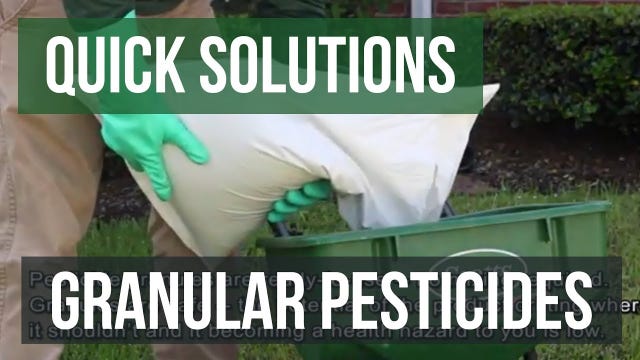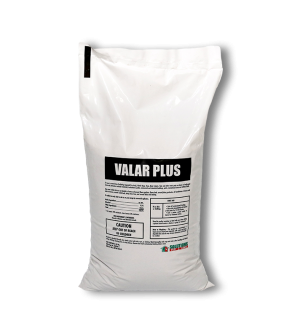Gain access to personalized product screening, the best pricing, rewards, and more!
Most Effective Products
Applying Granular Pesticides
Sometimes, conducting pest control treatments to eliminate insects that invade your home has to start from the outside rather than vice versa. That is when it may be better to use a product different from the conventional liquid insecticides. Granular insecticides kill ants, fleas, crickets, and other pests that hang around your lawn and garden, getting rid of their trouble before they begin invading indoors.
Pesticide granules consist of a solid particle filled with a strong insecticide. They are dry insecticides spread or broadcast over specific areas such as lawns, gardens, or flower beds.
Granular insecticides are an effective solution when you don’t want the mess of liquid insecticides, especially outdoors. By using granular insecticides and spreading them around lawns and flowerbeds, you can effectively manage problem pests that are trespassing indoors or eating at your plants.
In this guide, we will discuss the popular pest control technique of applying granular pesticides, how to effectively spread granules, the available options, and our top granular pesticide recommendations.
What Is Pesticide Granule Spreading?

Spreading pesticide granules is a method of pest control that involves using a granular formulation of pesticide uniformly spread onto a lawn or landscape to treat pest infestations that may be present or damaging turf and plants.
Pesticide granules usually consist of organic material such as sand, ground-up clay, or some other dry, solid substance embedded with a pesticide active ingredient, then bagged and spread. Pesticide granules often carry a broad label to treat many different common insects that may be hiding or residing in your yard, such as ants, beetles, spiders, fleas, chinch bugs, grubs, and many other types of insects.
It is important to differentiate between granular pesticides and granular baits, as they are not the same, despite what some people may believe. A granular bait is often a pesticide in granular form that also contains a food attractant. Granular pesticides, in general, are dry forms of liquid insecticides and are meant to deliver long-term control of pests that come in contact with a treated area.
Conditions For Applying Granular Pesticides

Granular Pesticides can be used on residential and commercial lawns, athletic fields, aquatic sites, rights-of-way, agricultural areas, flowerbeds, gardens and any other landscape where there are infestations of insects or plant damaging bugs.
Granular pesticides work best when applied to freshly mowed areas. This allows the insecticide to penetrate the soil better, so mow the area you wish to treat to a low height or as close to the ground as possible.
Our Recommendation
Valar Plus Bifenthrin Granules - Valar Plus Bifenthrin Granules is a ready-to-use granule insecticide that controls many types of insects like fleas, ticks, and fire ants. It is ideal for turfs and lawns around residential or commercial areas. This product is easy to apply and provides long-lasting effects.
Tools Needed
You will need a hand spreader or push-type broadcast spreader, gloves, long-sleeved clothing, and your selected granular pesticide to spread granule pesticides.
User Guide
Before applying and spreading pesticide granules, it is important to read the label for proper usage and the amount of granules needed to treat your yard. You should also calibrate your spreader according to the label's instructions for your spreader model.
Step 1: Measure the Square Footage of the Treatment Area

Finding the square footage of the treatment area will determine how many granules you will need to load your spreader to sufficiently broadcast onto the area for full coverage.
To do this, measure the treatment areas' length and width in feet, then multiply them together (length X width = square footage). The label will tell you how many pounds or ounces of granules to spread per 1,000 or so square feet.
Step 2: Load Your Spreader

Load your spreader with the correct amount of granules for your treatment area. If you're using a hand spreader, you may need to load the spreader multiple times, as hand spreaders are mainly for treating smaller areas. A push-type broadcast spreader is suggested if you have a larger area to treat.
Step 3: Spread the Pesticide Granules
Apply the pesticide granules as a broadcast over your treatment area. For uniform coverage, make two pass-throughs perpendicular to one another or grid-like.
Step 4: Water in the Granules
After evenly spreading your granules, water in them to activate them so the pesticide seeps into the soil and is released into the area to affect your target pest.
Benefits of Applying Granular Pesticides
- Granular pesticides are an effective way of treating a wide variety of common household insects or turf-damaging insects. The insecticide granules come ready to use, with no mixing required, as would be the case with liquid insecticides.
- Granular pesticides are also safer than liquid insecticides because the granules are dry, often large, and visible. Hence, the likelihood of accidentally ingesting the insecticide or being harmed by it is much lower.
- Granular spreading of pesticides is also very easy. All you need to do is load your spreader with the appropriate amount of pesticide and then spread it evenly onto the treatment area.
Drawbacks of Applying Granular Pesticides
- While spreading granular pesticides is easy, it can be difficult to apply uniformly if you have not properly calibrated your selected spreader tool that will be used to broadcast your specific granular pesticide.
- Most granular pesticides will need to be watered in to activate the product. If the granules are note watered in, the pesticide will be ineffective and will merely just sit stagnant in the soil where applied.
- There is a slight risk of accidental harm to non-intended target species, such as birds and beneficial creatures that may come across the granules and feed on them as if the pesticide granules were seeds or some food to enjoy.
Key Takeaways
What is Granular Spreading?
- Granular spreading is a pest control technique in which granular pesticides are uniformly spread over a landscape to treat invading pests in the turf.
How To Apply Granular Pesticides
- Granular spreading of pesticides is best performed on residential and commercial lawns and yards. First, calculate the square footage of the area to be treated to determine how many granules need to be loaded in a spreader.
- We recommend using Valar Plus Bifenthrin Granules as it carries a broad label of insects that it can treat and has a long residual effect of up to 90 days.
Proper Granular Spreading Technique
- Apply granular insecticide evenly to the turf by performing at least two pass-throughs perpendicular to one another.
- Use a push-type broadcast spreader to treat larger areas. A hand-type spreader is good for smaller areas or applications around trees, gardens, or flowerbeds.
- Water is used in the insecticide granules after application to activate them.









